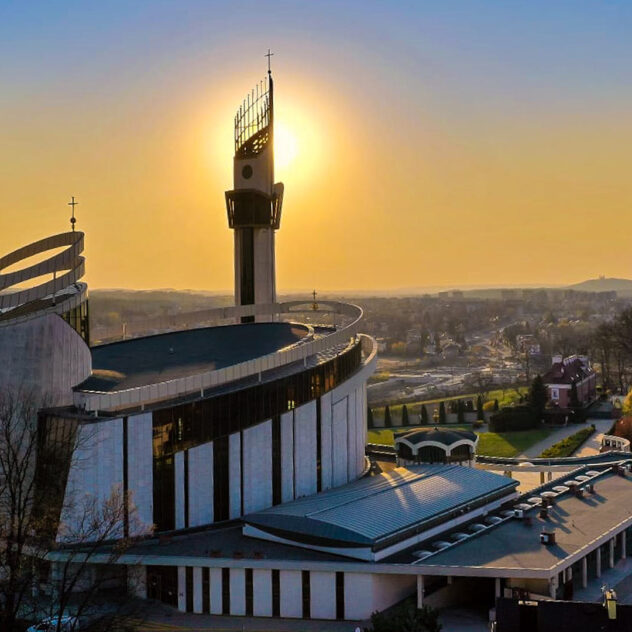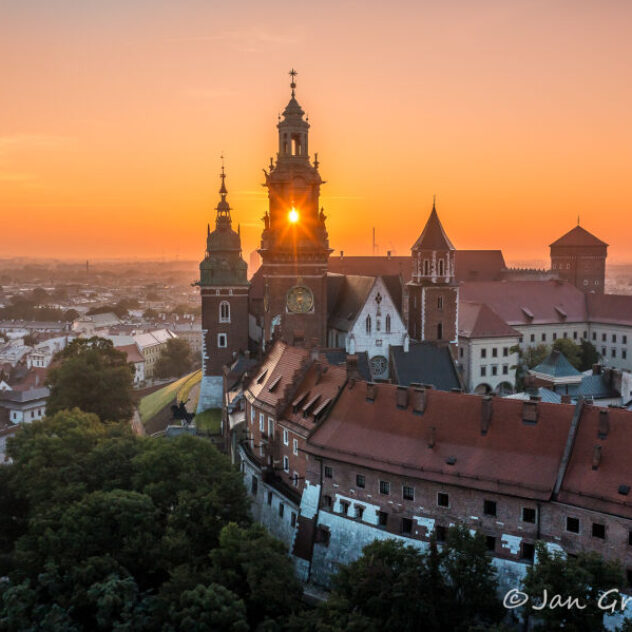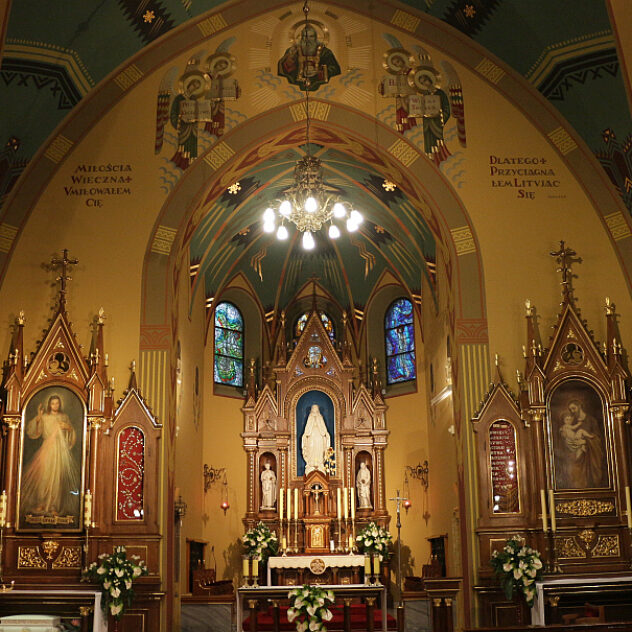The Shrine of the Divine Mercy in Kraków-Łagiewniki
Information about the pilgrimage site
The oldest buildings of the Sanctuary contain a chapel with the miraculous image of the Merciful Jesus and the tomb of St Faustina Kowalska, Apostle of the Divine Mercy.
The chapel dates from the end of the 19th century and is a foundation of Prince Aleksander Lubomirski. In 1968 Cardinal Karol Wojtyła, then Metropolitan of Krakow, included it in the list of sanctuaries of the Archdiocese of Krakow. The decree establishing the diocesan sanctuary was issued by Cardinal Franciszek Macharski, Metropolitan of Krakow, on 1 November 1992. The document reads: “Taking into consideration the vividly developing cult of the Divine Mercy in Kraków-Łagiewniki, I establish the existing chapel of the Sisters of Our Lady of Mercy there under the vocation of St. Joseph as a Divine Mercy Shrine. May this act increase the devotion of the people of God, asking for conversion and forgiveness there through the intercession of the Servant of God Sister Faustina Kowalska, on the eve of her beatification.”
In the chapel to the left of the main altar is the tomb of St Sister Faustina Kowalska (1905-1938), the Apostle of Divine Mercy, who spent more than five years in the Krakow convent. Here she did part of her religious postulancy and her two-year novitiate, as well as the last years of her life; here she worked, prayed and had mystical encounters with the inhabitants of heaven, most often with Christ and the Blessed Mother. From December 1936 to September 1938, Sister Faustina was treated twice in a hospital in Krakow’s Prądnik, as the doctors diagnosed her with tuberculosis. She died at 10.45 p.m. on 5 October 1938, in the convent of the Congregation in Kraków-Lagiewniki and was buried in the congregation’s cemetery in Łagiewniki. After the information process for the beatification of the Secretary of Divine Mercy had begun in the Archdiocese of Krakow, her mortal remains were transferred to the convent chapel – on 25 November 1966.
On 18 April 1993, John Paul II proclaimed Sister Faustina Blessed, and on 30 April 2000, the Polish nun was canonised in Rome. The coffin containing the mortal remains of Sister Faustina rests under the mensa of the altar with the grace-famous image of the Merciful Jesus.
St. Sister Faustina was asked to make the painting by the Lord Jesus Himself during an apparition in Plock, on 22 February 1931. This is how she described it in her “Diary”: “In the evening, when I was in my cell, I saw the Lord Jesus dressed in a white robe. One hand was raised in blessing and the other touched the robe on his chest. Two great rays, one red and the other pale, were coming out of the tilting of the robe on his chest. (…) After a while, Jesus said to me: ‘Paint a picture according to the drawing you see, with the caption: Jesus, I trust in you. I wish this image to be venerated first in your chapel and throughout the world”‘” (Acts 47).
The painting housed in the chapel was painted by the Cracovian painter Adolf Hyla (1897-1965) as a votive offering for his defence in perils during the Second World War and for graces received. The present painting was completed on 15 April 1944 and consecrated a day later by Fr Joseph Andrash SJ, Sister Faustina’s confessor and spiritual director.
Next to the image, and on the side walls, are showcases with votive offerings from many of the faithful grateful for the graces received. A small piece of Sister Faustina’s relics is also placed in a white marble kneeler in front of the altar. In the main altar of the chapel is a statue of Our Lady of Mercy – the patroness of the congregation. To the left is a statue of St Stanislaus Kostka, the patron saint of religious youth, and to the right is St Mary Magdalene, the patron saint of penitents. To the right of the main altar is an altarpiece with a painting of the chapel’s patron saint, St Joseph with Child. On the wall separating the presbytery from the nave, one can admire a fresco of God the Father surrounded by four angels.
Tourist attractions in the vicinity
Basilica of the Divine Mercy – the characteristic silhouette of the Basilica of the Divine Mercy rises near the old monastery. The site for its construction was consecrated in 1999 by Cardinal Franciszek Macharski, and less than three years later – on 17 August 2002 – the Holy Father John Paul II – during his last pilgrimage to his homeland – consecrated the shrine in Łagiewniki and there entrusted the world to The Divine Mercy.
The basilica was built according to a design by Witold Cęckiewicz in 1999-2002. In front of the entrance to the basilica during the Year of Mercy – 13 December 2015 – the Gate of Mercy was solemnly opened, on which deeds of mercy as to body and spirit are inscribed in Polish and English.
As soon as you enter the church, it is easy to see that its shape is reminiscent of a ship and evokes a modern-day ‘ark of the covenant’, where all those who hope in God’s mercy find salvation. In the chancel, behind the large stone altar, there is a tabernacle in the shape of a globe with outlined continents, which is surrounded by a bush torn by strong winds, symbolising the modern world and man tossed about by various currents. An image of the Merciful Jesus, painted by Jan Chrząszcz, is embedded in this bush above the tabernacle, where the outline of the continents is clearly visible. Next to it are paintings of the Apostles of Mercy: Saint Sister Faustina and Saint John Paul II by Teresa Śliwka-Moskal.
The rays from the Merciful Jesus image are alluded to by the layout of the wooden ceiling and marble floor, the elements of which are arranged in the shape of rays radiating out from the presbytery. To the right of the altar is the Act of Entrustment of the World to the Divine Mercy, which was made in the Basilica by the Holy Father John Paul II on 17 August 2002. On either side of the altar are showcases with votive offerings for graces received. In the porch of the Basilica are plaques commemorating the visit of the Holy Father John Paul II to Łagiewniki and the consecration of the Basilica, as well as the pilgrimage of Pope Benedict XVI (27 May 2006) and Pope Francis (30 July 2016).
On the other side you can see the foundation stone of Golgotha. It was consecrated by Pope John Paul II on 7 June 1997 in Łagiewniki. It was laid here by Cardinal Franciszek Macharski on 13 April 2002. The Basilica of the Divine Mercy has the largest stained glass window in Kraków – located above the choir – with an area of 148 m2. It depicts a huge sun with a luminous cross in the background – a symbol of faith and the most eloquent sign of God’s mercy. Below the horizon line is the sea, which harmonises in colour with the side stained glass windows in the basilica, intended to give the impression of rising from the depths of the sea. For more information https://www.misericordia.eu/pl/Bazylika-Bozego-Milosierdzia/ .
Viewing Tower – after leaving the Basilica on the left, there is a 77-metre-high tower (that’s how old Pope John Paul II was when he signed the project to build the new Sanctuary) topped with a cross. By lift or stairs (315 steps) you can get to the height of 46 metres, where there is a viewing platform from which you can see the panorama of Krakow and its surroundings, and in good visibility – even the Tatras.
Above the entrance to the tower is a statue of the Holy Father John Paul II, which shows the Pope holding a dove, a pilgrim of peace, bringing the gift of the message of Mercy to the world. It was unveiled on the occasion of Pope Benedict XVI’s pilgrimage to Łagiewniki in 2006. The viewing tower is open from 10.00 am to 6.00 pm.
The John Paul II Centre “Be not afraid!” – in Krakow’s White Seas, is located on the former “Solvay” factory’s post-operational grounds, not far from the place where a young worker, Karol Wojtyla, worked during World War II. It was then that the Polish Pope’s vocation to the priesthood was born, and he entered the clandestine Seminary. The Centre was established on 2 January 2006 in Krakow by Cardinal Stanisław Dziwisz as a votive offering of thanksgiving by the faithful for the Holy Father’s pontificate. It is His symbolic earthly home. The unique architectural complex, built according to a design by engineer Andrzej Mikulski, consists of: the Sanctuary of St. John Paul II the Great, the Museum of St. John Paul II the Great, the John Paul II Institute for Intercultural Dialogue, the Conference Centre, the Fatima Tower, the Pilgrim’s House, as well as rehabilitated green areas.
At the heart of this place is the Shrine of Saint John Paul II the Great, a space for prayer, for miracles, for leaning into the spiritual testament of the Saint, his inspiring legacy. Web: https://cjanpawel2.pl/ .
The centre of Krakow – that is, the Wawel Castle, the Market Square and St. Mary’s Church. The tram journey from the pilgrimage site in Łagiewniki takes about 20 minutes. While in the centre of Krakow, you can visit many churches, museums, theatres, the Jewish quarter of Kazimierz and other important sites for Poland’s history and cultural heritage.
Other tourist attractions near the pilgrimage site can be found on the website of the Malopolska Tourist Information System: https://visitmalopolska.pl/.
Accommodation
- Accommodation for pilgrims: St. Faustina House (https://domsiostryfaustyny.pl/pokoje-goscinne/ ), or Krakow House for Pilgrims and Tourists “Promień” (https://www.pielgrzym.krakow.pl/site-11.html )
- Other private accommodation is also available.
Availability
By car
Those travelling by car can drive up to the Sanctuary itself, next to which there is a car park.
By public transport
Those travelling by train can get off at the Krakow-Łagiewniki railway station and walk a bit uphill. The Sanctuary is perfectly visible from the station itself. You can also get to the Krakow Główny station and from there take tram number 10 to the “Sanctuary” stop. Then go through the subway and take the short walk up the hill.
On foot
Footpaths lead to the sanctuary.
On a bicycle
Cycle paths also lead to the Sanctuary.







